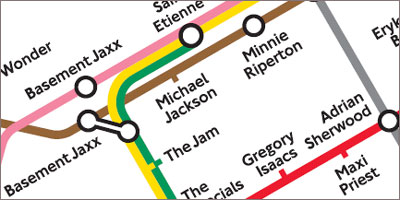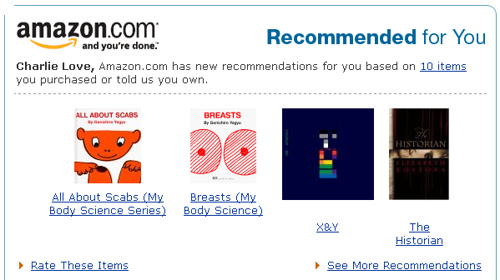There are a few sites out there devoted to help people find covers. My favorite is the Cover Project.
Sunday Feb 05, 2006
There are a few sites out there devoted to help people find covers. My favorite is the Cover Project.
Saturday Feb 04, 2006

There's a PDF too. (First seen on BoingBoing).
Friday Feb 03, 2006
Social recommenders can often come up with rather strange associations that sometimes just don't seem to have any rhyme or reason. Here's one seen in the Flickr group on AmazonRecommendations:

Probably the worst way to browse through a music collection is by having to read through long lists of words. The web is rife with them, like this. Part of the joy of collecting music has always been to be able to interact with it physically, to hold an album in your hand, to read the liner notes, to arrange it, to show it off. In the digital world, all you really can do is to show people your iPod, it is not the same. I think that we'll start seeing some attempts at bringing back some of the pleasure that comes with interacting with your music collection. One attempt is CoverFlow Coverflow allows you to browse through your album collection and interact with it, just like you use to be able to do. It is quite slick (although it is still in beta, requires a Mac and crashes a lot). It does remind me a bit of the looking glass CD app that was demonstrated a few years back. Here's a picture of coverflow - click to see a video of CoverFlow in actions:

CoverFlow - The first of the next wave of apps to make interacting with your music much more enjoyable.
Thursday Feb 02, 2006
Wednesday Feb 01, 2006
Tuesday Jan 31, 2006
Music charts have traditionally been a good way for people to find new music. Every week there's a new set of top ten (or top 40, or top 200) songs to browse and listen to, and perhaps one is a keeper.
Nowadays there are a number of online music charts to explore ... There's trusty old Billboard, with its traditional charts organized by genre. Yahoo is now offering a Konfabulator widget that shows the charts from Yahoo! Music Unlimited.
My favorite set of online charts are from last.fm. What's unique about the last.fm charts compared to the traditional Billboard charts is that Last.fm is tracking song plays, not song purchases. The more a song is played, the higher it goes in the charts while a song that is purchased but is never played goes nowhere. I've probably purchased 20 CDs this year, most of them based on the last.fm charts, and I've happily discovered bands that I didn't know before from Franz Ferdinand, to Death Cab for Cutie. The chart topper at last.fm this week is 'Such Great Heights' by thePostal Service, and it's next on my "to buy" list.
Monday Jan 30, 2006
Yahoo and Linksys have teamed to deliver the Music Bridge that will bridge the gap (wirelessly) between your PC and your stereo to allow you to listen to your yahoo music in your livingroom. The location of our music is slowly shifting from the stack of CDs next to the stereo to the PC in the office, and eventually into the backroom at Yahoo or Apple.
Sunday Jan 29, 2006
For iTunes and Rhapsody, being the main distribution point for independent music will be a key distinguishing feature over the every shrinking music department in the local WalMart. Offering 10,000,000 or 100,000,000 different songs, including songs by the band that plays in the local eatery every friday night will drive new customers to the online store. The key problem, however, for the iTune and Rhapsody is to figure out how to drive people into the long tail, to find new music that they'll like.
Already, there has been quite a bit of effort made around social recommendation and collaborative filtering to help people find new music. Last.fm is one of the most successful examples of this. However, social recommendation suffers from a 'popularity bias'. Social systems tend to favor what is popular, so what is popular gets recommended more and becomes even more popular. It is hard for an unknown independent artist to make headway with this type of recommendation. That's where content-based recommendation can be helpful. Content-based systems recommend music based on 'what it sounds like', instead of 'who is listening to it'. With a content-based recommender I can say 'find me music that sounds like the song "Take five"' and I should get a list of recommendations or songs that sound similar.
Currently there are very few content-based recommendation engines. There's Predixis, that uses automated, computer analysis to determine similarity and Pandora that uses musicians to characterize music conent. It's still early days for content-based recommenders, and there's plenty of room for improvement in the quality of recommendations. I suspect, though that soon these content-based recommenders will be key to driving listeners into the long tail, to help people find that independent artist.
20 years ago a new artist needed a record company to be successful for three reasons: the recording studio, the record promotion and the distribution channel. Today, a recording studio is cheap and distribution is easy. The last piece of the puzzle is helping listeners find the new artist's music.
Saturday Jan 28, 2006
Audio for the recent Plork Concert is now online ... ten pieces of live computer music performed by the Princeton Laptop Orchestera. Here's the description of one piece ... The Plork Tree, from the program notes:
Thursday Jan 26, 2006
Monday Jan 23, 2006
Anyone who shops at Amazon is familiar with the "People who bought XXX also bought YYY"" recommendations that dominate the front page. These recommendations must work because Amazon and other online stores rely on them heavily. However, there are problems with these automated recommenders such as unfortunate pairings made recently by Walmart. For one thing, Amazon doesn't seem to notice that kids grow up. Five years ago, for example, I bought some books in a series for my 9 year-old daughter. Now five years later, I still get recommendations for books in the same series even though my daughter is 14 years old and wouldn't be caught dead reading a book from that series (at least she wouldn't be caught dead being seen reading one).
Rebecca points me to an article in yesterday's New York Times called "Like This? You'll hate that. (Not all web recommendations are welcome)" that describes some of the problems with today's recommenders. An interesting read.
Sunday Jan 22, 2006
In his Ongoing blog Tim Bray mentions that he'll be giving a talk at this year's JavaOne called: Sigrid: The simplest possible grid computing platform. If I make it to JavaOne this year, I'll put this talk at the top of my list. There's a big gap right now in Grid Computing. There are Grid Computing APIs, but these seem to be designed for the traditional big iron apps like those used by chemical companies and Wall Street. It is hard to write grid apps with these APIs. In order to get more programmers and companies to think about moving their apps to the grid, it has to be easier to write grid apps. In particular this means:
- Use a friendly programming language like Java
- Be able to develop and test on a desktop system
- Have a minimal API
public <T> List<Future<T>> invokeAll(Collection<Callable<T>> tasks, long timeout);
With this method (based on the invokeAll method from the
java.util.concurrent.ExecutorService), a programmer can build a list of
tasks to be executed on the grid. The method will return a list of
futures that are then used to determine when the tasks have completed
(or failed). The SPAWN framework will put the callable tasks into a
JavaSpace. Waiting on this space are SPAWN process servers that will
pull the tasks out of the space, execute the code and put the answers
back into the space where they are reaped by the client. The
leases and transactions supported by JavaSpaces make this system very
reliable. If any of the systems processing one of the tasks goes down
its lease on the task will expire and the task will be given to another
system to process.
I'll very interested in seeing what Tim's 'simplest possible grid
computing platform' is like. I'm especially curious to see if it will be
simpler than SPAWN.
This blog copyright 2010 by plamere